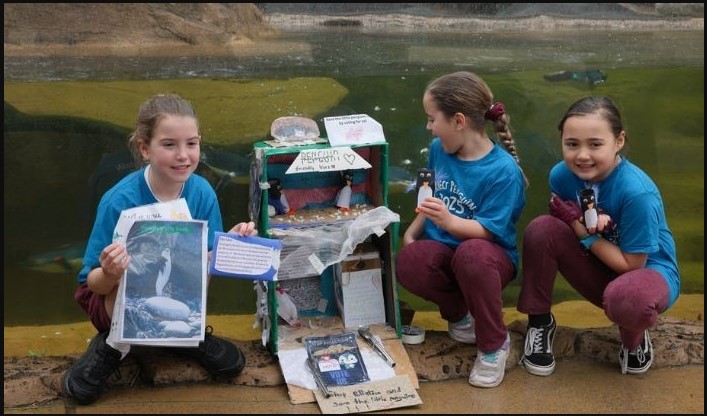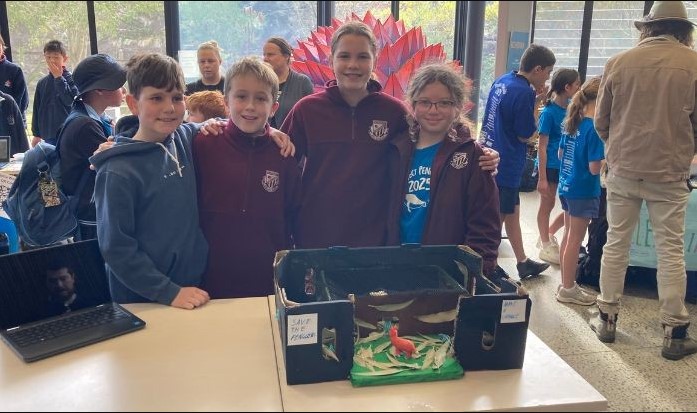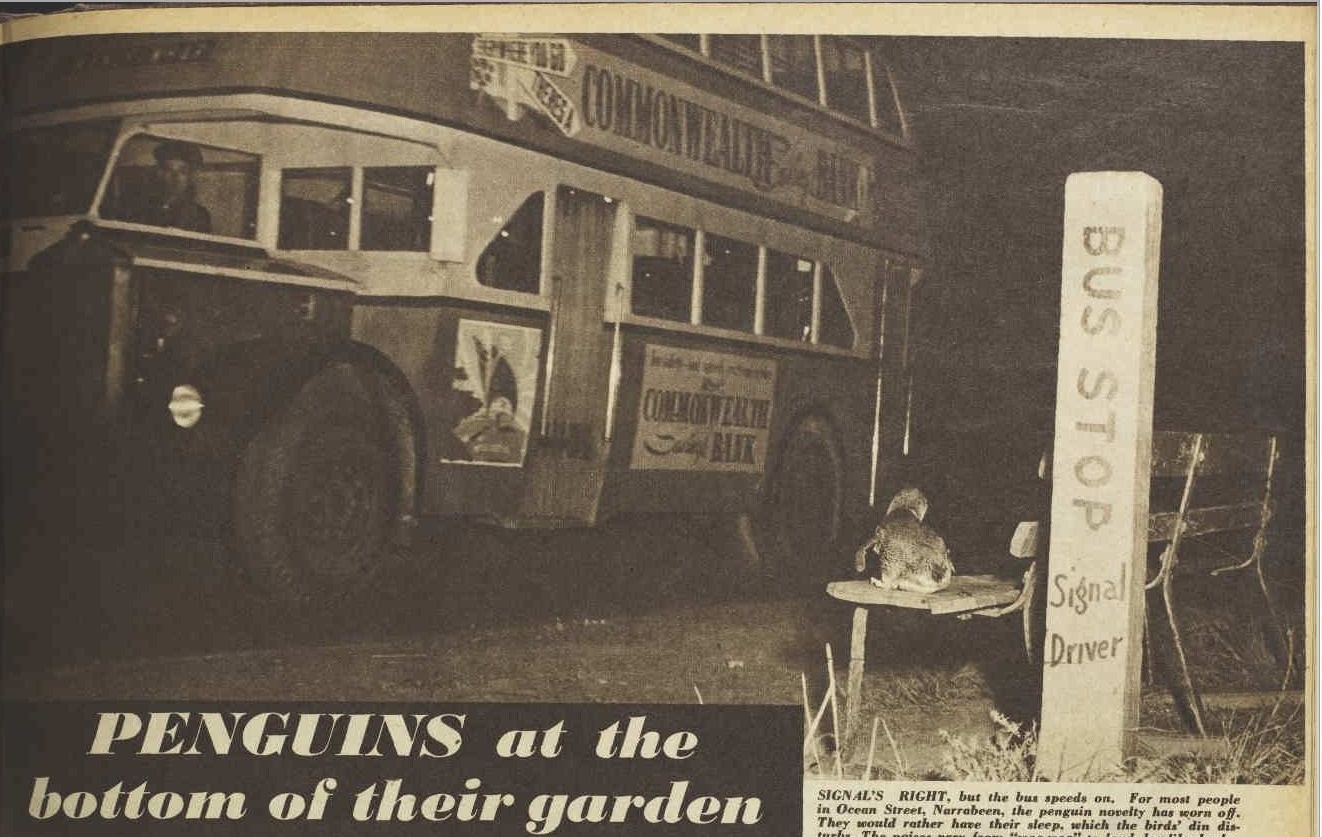Project Penguin 2025 + Surfing with a Penguin in South Africa + Pittwater's Penguins
Surfing with a Penguin
Here's some nice news for all who love encountering fairy penguins, based on Lion Island or at Manly, when in the waters offshore of our area. Details on further local Fairy Penguin news runs below.
Alan van Gysen, a renowned photographer and filmmaker based in Cape Town, has captured an amazing array of moments but says nothing was quite like this recent experience he and a group of surfers had with a penguin at Noordhoek Beach.
"From sharks to seals to whales and everything in-between, Cape Town in South Africa is renowned for wildlife encounters in the water. But it’s rare for surfers to see a penguin, let alone share a few waves with one – until this little guy came along." he says in the film, published August 16 2025
"It was one the most incredible wildlife experiences I've ever had in my 25 years of photography. You know, down this beach, and around Cape Town, I've had interactions with whales, seals, dolphins, and even sharks, but I've never experienced anything quite like this...I'm pretty blown away to be honest."
Coming from Mr. van Gysen , that's saying something. He's taken his camera all across the African continent as well as documented some of the most iconic waves in the world for the "Origin Series" by Now Now Media, the production company he runs with journalist Will Bendix. Together they've told the story of such waves like Puerto Escondido, Safi, Skeleton Bay, African Kirra, and more.
The creators state African Penguins are critically endangered. You can directly help efforts to save them by supporting organisations like SANCCOB. Visit: https://sanccob.co.za/
Two days later, Monday August 18, it was reported nine African penguins, rescued and rehabilitated by SANCCOB, were released back into the wild, marking a significant victory for marine conservation.
Following months of extensive care and rehabilitation at the Southern African Foundation for the Conservation of Coastal Birds (SANCCOB), dedicated team members sporting the biggest smiles and holding back tears of joy witnessed the fruits of their labour culminate in a rewarding moment and step forward for marine conservation.
A video shared by SANCCOB shows the team carefully moving large boxes to the beach before opening them to reveal the penguins they had dedicated so much effort to treating and preparing for rewilding. The birds were guided out of their boxes and onto the beach, where they walked together into the water before swimming into the horizon to continue their life in their ocean home.
In the last century, African Penguins have lost 97% of their population. The penguins’ main food sources, sardines and anchovies, are being depleted by commercial fishing.
On March 18 2025 BirdLife South Africa and SANCCOB secured a historic victory for South Africa’s Critically Endangered African Penguin when the Pretoria High Court issued an order of court after a hard-won settlement agreement was reached by the two conservation NGOs with commercial sardine and anchovy purse-seine fishers (subsequently endorsed by the State). The order provides for the delineations of no-take zones for the commercial sardine and anchovy fishery around six key African Penguin breeding colonies that lie within coastal areas where this commercial fishery operates.
SANCCOB stated: ''The six closures work together to secure biologically meaningful foraging areas for African Penguins in each of the west coast, southern Cape and Algoa Bay regions to help bring the species back from the brink of extinction. This settlement follows several weeks of exceptionally hard work and negotiations between the conservation NGOs and the commercial sardine and anchovy fishing industry.''
Surfing with a Penguin | Surf's Up for Real
A short film by Now Now Media presented by Monster Energy in association with O’Neill
Featuring Eli Beukes, Brendon Gibbens and others
Produced by Alan van Gysen
Written and Directed by Will Bendix
Primary pupils’ projects to protect Manly's little penguins
Peninsula public schools have teamed up with Taronga Zoo to help protect little penguin colonies. Jim Griffiths reports.
August 22 2025

Students from Brookvale Public School get a seal of approval from the penguins
The last onshore little penguin colony on Sydney’s northern beaches is overcoming threats to its survival thanks to a project involving Department of Education Zoo Education Team, Taronga Zoo and eight northern beaches public schools.
For 10 weeks, primary school students – with their high school mentors – undertake a range of activities to deepen their knowledge of Manly’s little penguins, threats to the colony and positive actions that we can all take to protect the species.
Relieving Zoo Education Advisor, Alexandra Heagney, said the primary school students had to solve one of the problems that the little penguins face, develop their own prototype solutions and create a community awareness campaign focused on protecting the penguins.
“What we hope to see out of this project is community awareness and students becoming advocates for the little penguin colony in Manly,” she said. “We also hope to see that they make changes when they become adults and teenagers too.”
During Project Penguin, the primary students are guided through the design thinking process and are supported by local high school student mentors.
The project follows a project-based learning framework implemented across a number of the department’s Zoo Education programs, with a focus on authentic cross-curricular learning focused on a locally threatened species.
The 22 best ideas were then shared at a Taronga Zoo expo attended by more than 640 students from Balgowlah Heights, Beacon Hill, Brookvale, Harbord and Manly West Public Schools and their mentors from Northern Beaches Secondary College Cromer, Balgowlah Boys and Mackellar Girls and The Beach School.
For example, one team from Harbord Public School developed a habitat with a surrounding pressure plate to detect anything heavier than a penguin.
Once activated, fox repellent and water are sprayed, along with noise from speakers to scare off any predator, with nets providing further protection from sea birds.
Brookvale Public School Year 3 student Neve Gordon enjoyed working on an idea to make better, storm-proof bins to reduce plastic pollution on the coastline.
“My favourite part of the project was working in groups and making things,” she said.

Harbord Public School students show their project at the ‘Project Penguin Expo’
WHY PENGUINS?
- They’re an indicator species: Little penguins are at the top of the marine food chain for small fish and invertebrates. If their population declines, it can signal bigger environmental problems such as pollution, overfishing, or climate change.
- They help maintain ecosystem balance: By feeding on small fish, squid, and krill, little penguins help keep prey populations in check.
- They’re part of Sydney’s coastal identity: The Little Manly colony is the only breeding penguin colony left on the NSW mainland. They are a living connection to what Sydney’s coastline looked like long before the city grew around it, but they face challenges such habitat loss, pollution and the impacts of climate change.
- They’re unique and irreplaceable: Little penguins are the smallest penguin species in the world, and the Little Manly colony is one of the most urban penguin populations anywhere. If they disappear here, they’ll never naturally return, it would be the end of a centuries-old population.
________________________________________________
Pittwater's Penguins
A few insights from the news service from a few years ago.
In June 2019 we brought you some news about a project to put fireproof burrows on Lion Island for the colony that lives there - these penguins are seen in the Pittwater estuary and right along the coastal beaches. They used to have nests and colonies on the beaches all along our coast as well - at Turimetta Beach, Narrabeen and Long Reef in particular.
They are still seen at Barrenjoey, through the Pittwater estuary and off our beaches, right along the coast from Palm Beach to Long Reef.
More in:
Lion Island's Little Penguins (Fairy Penguins) Get Fireproof Homes - thanks to NSW National Parks and Wildlife Service and the Fix it Sisters Shed
Here's some at Narrabeen in 1955 - and reports of them at Long Reef as well:
When summer comes . . .
.jpg?timestamp=1619878281381)
HE MUST go down to the sea again, the lonely sea and the sky- but only for dinner. This hungry little chap couldn't wait for the rest of the flock that gathers for a nightly 3 a.m. party on the beach. Then they return to their nests to sleep all day.
.jpg?timestamp=1619878349216)
HOUSING TROUBLES begin, at Mrs. E. Whittaker warns off a mother bird for squatting with its young beside her shed. But (inset) the penguin family sits tight till ready to vacate.
PENGUINS at the bottom of their garden
Spring comes with a difference to the gardens of waterfront homes in Ocean Street, Narrabeen, north of Sydney. It brings flocks of fairy penguins-the smallest of the breed-sauntering in from the sea to take up residence for their nesting season. As daytime guests they're welcome, but at nightfall they head down to the sea for food-making noises that keen everyone else awake, too. They stay for a few months.

HUNTING for invaders under the house, this family is helped by neighbors. Householders have M tried fencing and boarding around their houses, but still the penguins come to nest each year.
SIGNAL'S RIGHT, but the bus speeds on. For most people in Ocean Street, Narrabeen, the penguin novelty has worn off. They would rather have their sleep, which the birds' din disturbs. The noises vary from "woo-woo" to loud dog-like barks.
.jpg?timestamp=1619878478650)
THE MAN who came to dinner takes it for granted he's welcome as Mr. W. Gillanty greets him. Residents, particularly light sleepers, now have to resign themselves to a trying time while the penguins, which are protected, are in charge. PENGUINS at the bottom of their garden (1956, December 12). The Australian Women's Weekly (1933 - 1982), p. 23. Retrieved from http://nla.gov.au/nla.news-article41852332
Marine Parade North Avalon resident and ornithologist Neville Cayley is mentioned in this one:
Two Little Penguins
AS Mr. Neville Cayley mentions in the 'Mail' that there is very little known regarding the length of time these penguins care for their young before turning them out, I thought the following account would be of especial interest to readers of 'Outdoor Australia.'
At a crowded Museum lecture Mr. Kinghorn told us this unusual incident. One morning towards the end of August, 1921, the peace and serenity of some dwellers at Collaroy Beach were disturbed by extraordinary noises and weird cries at the back door. When the astonished owner of the house opened the door in rushed two little penguins, which with loud voices announced their intentions of staying. Then they danced about and waved their little wings in a most ingratiating way. After a short time these noisy visitors were shown the door, and they disappeared for a while. But, having chosen their home, Mr. and Mrs. Penguin returned later, and as they could not get inside the house they went underneath as far as they could get, and there made their nest of seaweed. The noise every night was almost unbearable; they would scream and cackle, and later, after about six weeks their songs of joy were terrific, for two youngsters were hatched.
About four months after their arrival the penguin family suddenly departed. Where they wintered is their own secret: but late in the following August a terrible cackling outside advised these householders that they were back. When the door was opened Mr. and Mrs. Penguin marched triumphantly in, followed by two grown chicks, which were inquisitive and rather shy. Then followed extravagant dances of greeting and vociferous songs of 'Here we are again,' etc., in which the young ones also joined.
They could not be quietened, and the neighbours hastened across to see if someone had gone mad. The owners of the house put the whole family down on the beach and drove them away. It was then that the parents sent off the chicks to fend for themselves, and they themselves returned later and went under the house to their old nest. The celebrations were so overpowering that the householders took down some boards next day, got the noisy pair out, and drove them at night by car to Palm Beach, about twelve miles distant, and there left them. But next morning saw them back.
They were taken a second time, but returned, and were allowed lo stay; but a home was made for them in the far corner of the garden. The house side was netted off and a hole cut in the fence to allow them free access to the beach. They made a nest of seaweed, and later two eggs were laid. The birds look it in turn to sit on them, and there was always much shouting and scolding when one returned from the sea at night.
After about six weeks two sooty-brown chicks appeared, and the noise that night and the next few days while the celebrations lasted was tremendous. The parents took it in turn to fish and swim during the day that followed, but at night they often went out together to find a suitable supper, and about 9 p.m. would return, arguing together as they came up the beach. The following summer my father saw a young penguin land on the rocks at Coogee. I think it quite likely that it was one of the young ones turned out at Collaroy. It was evidently not very used to fending for itself, for a patch of feathers was torn from its shoulder, possibly through not being an adept at landing.
At the time of the lecture these queer visitors were still in residence at Collaroy, and what became of them I do not know. It is likely enough that the nesting-place on North Head mentioned by Mr. Cayley is occupied by these little penguins or their descendants. Outdoor Australia (1925, March 18).Sydney Mail (NSW : 1912 - 1938), , p. 10. Retrieved from http://nla.gov.au/nla.news-article159721727
It is recorded that two Fairy penguins for a number of years made seasonal visitations to Collaroy, near Sydney, and often laid their eggs under the floor of one of the houses there. — F.J.B. Quaint and Beautiful Sea Birds (1934, October 31). Sydney Mail (NSW : 1912 - 1938), , p. 56. Retrieved from http://nla.gov.au/nla.news-article166107257
The Lion Island colony was officially first protected in 1956 - although they had been protected decades prior to then:
PROTECTION OF PENGUINS.
Mr. Oakes (Chief Secretary), who is in charge of the Act relating to wild life, desires it to be generally known that all species of penguins are absolutely protected by law, and that anyone interfering with the birds is liable to a penalty. Apart from this he says citizens are requested to refrain from molesting this interesting bird, or driving it back to the sea, as, naturally, no water fowl liked getting wet when half-feathered.
Mr. Oakes remarked yesterday that fairy penguins, which were frequently seen off the coast, came ashore at this period of the year for moulting purposes for about three weeks. During that time they had not been observed to feed or enter the water. Many persons had offered specimens of the birds as exhibits to the Taronga Zoological Gardens, while others had made inquiries how to keep them alive in captivity. As this species of penguin only lived on live fish they could not be kept alive away from the sea. PROTECTION OF PENGUINS. (1923, December 18). The Sydney Morning Herald (NSW : 1842 - 1954), p. 8. Retrieved from http://nla.gov.au/nla.news-article16127509
PENGUINS ON COAST ARE PROTECTED
A penguin caught to-day near Palm Beach was refused' by Zoo authorities. The birds are common along the coast at present, are protected by law, and do not live in captivity.
The secretary of the Zoo (Mr. H. B. Brown) said today that the public had been warned against molesting the birds. PENGUINS ON COAST ARE PROTECTED (1936, December 30). The Sun (Sydney, NSW : 1910 - 1954), p. 12 (COUNTRY EDITION). Retrieved from http://nla.gov.au/nla.news-article230907746